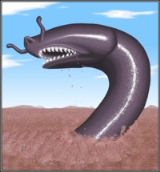
Minhocão
Encyclopedia
The minhocão is a large earthworm
-like cryptid
that allegedly exists in the forests of South America
.
Karl Shuker
has suggested that this animal may be an example of a giant caecilian
, which fits the description of the minhocão well. However, known caecilians do not even begin to approach the supposed size of this animal. In On the Track of Unknown Animals
, Bernard Heuvelmans
suggests that the animal may be a surviving glyptodont.(despite the obviouse differences)
Earthworm
Earthworm is the common name for the largest members of Oligochaeta in the phylum Annelida. In classical systems they were placed in the order Opisthopora, on the basis of the male pores opening posterior to the female pores, even though the internal male segments are anterior to the female...
-like cryptid
Cryptid
In cryptozoology and sometimes in cryptobotany, a cryptid is a creature or plant whose existence has been suggested but is unrecognized by scientific consensus and often regarded as highly unlikely. Famous examples include the Yeti in the Himalayas and the Loch Ness Monster in...
that allegedly exists in the forests of South America
South America
South America is a continent situated in the Western Hemisphere, mostly in the Southern Hemisphere, with a relatively small portion in the Northern Hemisphere. The continent is also considered a subcontinent of the Americas. It is bordered on the west by the Pacific Ocean and on the north and east...
.
Appearance
It reportedly resembles a giant worm, with scaly black skin and a pair of tentacle-like structures protruding from its head. It is thought to be a burrowing animal, producing enormous trenches as it digs.Identity
CryptozoologistCryptozoology
Cryptozoology refers to the search for animals whose existence has not been proven...
Karl Shuker
Karl Shuker
Karl P. N. Shuker is a British zoologist, cryptozoologist, and author living in the West Midlands, England. He works as a full-time freelance zoological consultant, media consultant, and noted author specializing in cryptozoology.- Career :...
has suggested that this animal may be an example of a giant caecilian
Caecilian
The caecilians are an order of amphibians that superficially resemble earthworms or snakes. They mostly live hidden in the ground, making them the least familiar order of amphibians. All extant caecilians and their closest fossil relatives are grouped as the clade Apoda. They are mostly...
, which fits the description of the minhocão well. However, known caecilians do not even begin to approach the supposed size of this animal. In On the Track of Unknown Animals
On the Track of Unknown Animals
On the Track of Unknown Animals is a cryptozoological book by Belgian-French author Bernard Heuvelmans that was first published in 1955 under the title Sur la Piste des Bêtes Ignorées. The English translation by Richard Garnett was published in 1958 with some updating by the author and with a...
, Bernard Heuvelmans
Bernard Heuvelmans
Bernard Heuvelmans was a Belgian-French scientist, explorer, researcher, and a writer probably best known as "the father of cryptozoology"...
suggests that the animal may be a surviving glyptodont.(despite the obviouse differences)

